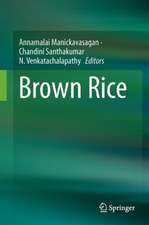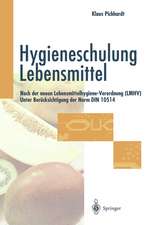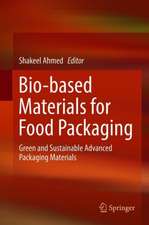Food Immunoassay
Autor Chuanlai Xu, Hua Kuang, Liguang Xuen Limba Engleză Paperback – 27 noi 2020
| Toate formatele și edițiile | Preț | Express |
|---|---|---|
| Paperback (1) | 1004.67 lei 6-8 săpt. | |
| Springer Nature Singapore – 27 noi 2020 | 1004.67 lei 6-8 săpt. | |
| Hardback (1) | 1010.03 lei 6-8 săpt. | |
| Springer Nature Singapore – 27 noi 2019 | 1010.03 lei 6-8 săpt. |
Preț: 1004.67 lei
Preț vechi: 1225.20 lei
-18% Nou
Puncte Express: 1507
Preț estimativ în valută:
192.24€ • 209.48$ • 161.99£
192.24€ • 209.48$ • 161.99£
Carte tipărită la comandă
Livrare economică 23 aprilie-07 mai
Preluare comenzi: 021 569.72.76
Specificații
ISBN-13: 9789811390364
ISBN-10: 9811390363
Pagini: 363
Ilustrații: XV, 363 p. 447 illus., 57 illus. in color.
Dimensiuni: 155 x 235 mm
Greutate: 0.58 kg
Ediția:1st ed. 2019
Editura: Springer Nature Singapore
Colecția Springer
Locul publicării:Singapore, Singapore
ISBN-10: 9811390363
Pagini: 363
Ilustrații: XV, 363 p. 447 illus., 57 illus. in color.
Dimensiuni: 155 x 235 mm
Greutate: 0.58 kg
Ediția:1st ed. 2019
Editura: Springer Nature Singapore
Colecția Springer
Locul publicării:Singapore, Singapore
Cuprins
Introduction of immunoassay.- Mycotoxin immunoassay in food.- Heavy metal immunoassay in food.- Pesticide immunoassay in food.- β-agonist and artificial hormone immunoassay in food.- Antibiotics immunoassay in food.- Illegal additives immunoassay in food.- Pathogen immunoassay in food.- Food allergy Immunoassay.- Food nutrition Immunoassay.
Notă biografică
Chuanlai Xu is a Full Professor at the International Joint Research Laboratory for Biointerface and Biodetection, and State Key Laboratory of Food Science and Technology, Jiangnan University in China. He obtained his doctorate from Jiangnan University in 2002, and was a Visiting Scholar at the University of East Anglia (2007) and the University of Michigan (2008). For almost 20 years his research has focused on fast detection technology and measures, and to date he has developed more than 400 monoclonal antibodies against mycotoxins, antibiotics, pesticides, and hormones. Over 80% fabricated fast reagents and devices, such as enzyme-linked immunoassay, immunoaffinity materials and strip sensors have been widely used in the food industry and in-field detection. He has published over 300 peer-reviewed articles and holds over 200 patents. He is the EIC of Food and Agricultural Immunology.
Hua Kuang is a Full Professor at State Key Laboratory of Food Science and Technology, Jiangnan University in China. She received her BS degree (2003) from Jiangnan University, and her MS (2006) and PhD (2009) degrees from the China Agricultural University. She was a postdoctoral fellow (2012–2013) at the City University of Hong Kong. She has mainly focused on the plasmonic circular dichroism properties of nanoscale self-assemblies and fabrication of detection probes for biological applications. She has published more than 100 peer-reviewed journal articles, and has received various awards, including from the Excellent Youth Foundation of Jiangsu Scientific Committee (2014), Young top-notch talent (2014), Excellent Youth Foundation (Ministry of Science & Technology) (2015), Cheung Kong Young Scholar (Ministry of Education of China) (2015), Youth Science and technology innovation Pioneer (Ministry of Science & Technology) (2016) and APEC Science Prize for Innovation, Research and Education (Asia-Pacific Economic Cooperation) (2016). She is an associate editor of Science Bulletin.
Liguang Xu is a Full Professor at the School of Food Science and Technology at Jiangnan University, China. He received his BS degree (2006) in Food Science from Qingdao Agricultural University, and his MS (2009) in Food Science and PhD (2012) in Biosensors from Jiangnan University. His PhD research focused on the surface-enhanced Raman scattering and circular dichroism properties of nanoparticle diverse superstructures. He was a Postdoctoral Fellow (2015–2016) at the University of Michigan, where he cooperated with Prof. Nicolas A. Kotov, studying the application of plasmonic circular dichroism for sensing DNA fragments of resistant bacteria in blood. His current interests include design and synthesis of nanoparticle assembled superstructures applied in biological systems.
Hua Kuang is a Full Professor at State Key Laboratory of Food Science and Technology, Jiangnan University in China. She received her BS degree (2003) from Jiangnan University, and her MS (2006) and PhD (2009) degrees from the China Agricultural University. She was a postdoctoral fellow (2012–2013) at the City University of Hong Kong. She has mainly focused on the plasmonic circular dichroism properties of nanoscale self-assemblies and fabrication of detection probes for biological applications. She has published more than 100 peer-reviewed journal articles, and has received various awards, including from the Excellent Youth Foundation of Jiangsu Scientific Committee (2014), Young top-notch talent (2014), Excellent Youth Foundation (Ministry of Science & Technology) (2015), Cheung Kong Young Scholar (Ministry of Education of China) (2015), Youth Science and technology innovation Pioneer (Ministry of Science & Technology) (2016) and APEC Science Prize for Innovation, Research and Education (Asia-Pacific Economic Cooperation) (2016). She is an associate editor of Science Bulletin.
Liguang Xu is a Full Professor at the School of Food Science and Technology at Jiangnan University, China. He received his BS degree (2006) in Food Science from Qingdao Agricultural University, and his MS (2009) in Food Science and PhD (2012) in Biosensors from Jiangnan University. His PhD research focused on the surface-enhanced Raman scattering and circular dichroism properties of nanoparticle diverse superstructures. He was a Postdoctoral Fellow (2015–2016) at the University of Michigan, where he cooperated with Prof. Nicolas A. Kotov, studying the application of plasmonic circular dichroism for sensing DNA fragments of resistant bacteria in blood. His current interests include design and synthesis of nanoparticle assembled superstructures applied in biological systems.
Textul de pe ultima copertă
This book systematically covers immunoassays for food, presenting detailed approaches such as antigen design, food matrix pre-treatment and detection format optimization for 9 classes of food hazards and nutrition constituents. Offering ideas on how to improve the efficiency of recognized xenobiotics and food contents, this practical book also describes the discovery and utilization of novel immune agents like aptamer and molecular imprinted polymers in food analysis. It is intended for a broad range of areas, including biologists and food chemists, and is sure to become a key reference resource for students and professionals alike.
Caracteristici
Offers comprehensive details of immunoassay in the field of food safety Describes immunoassays for 9 classes of food hazards and nutrition constituents Introduces the latest developments in food safety analysis Serves as a practical resource on food immunochemistry





















